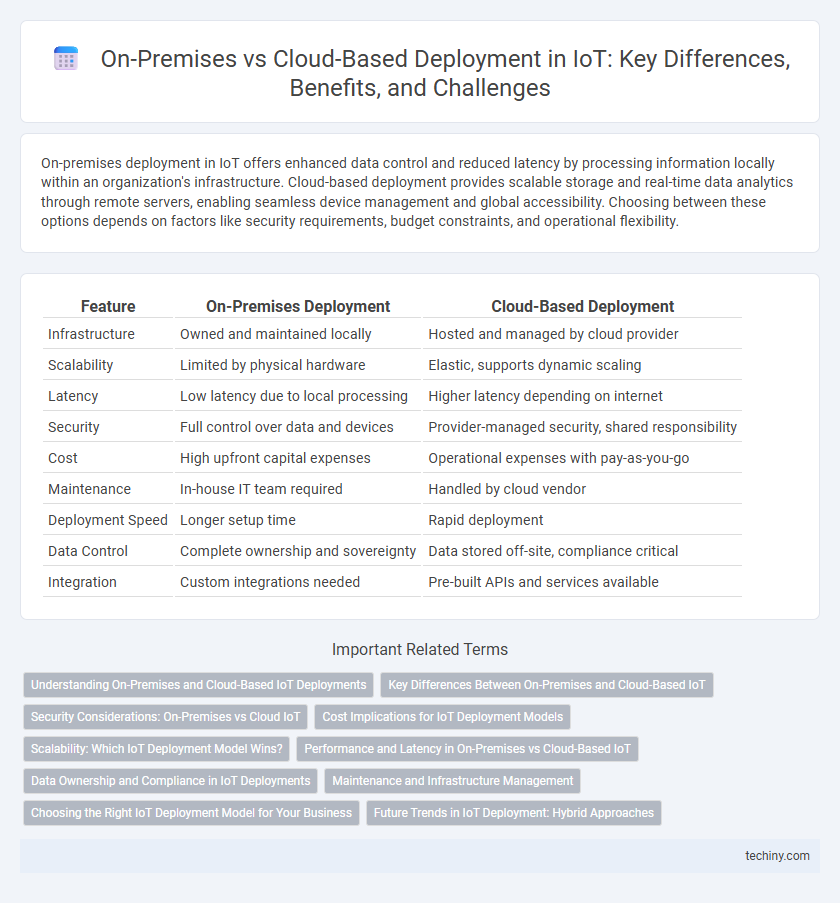On-premises deployment in IoT offers enhanced data control and reduced latency by processing information locally within an organization's infrastructure. Cloud-based deployment provides scalable storage and real-time data analytics through remote servers, enabling seamless device management and global accessibility. Choosing between these options depends on factors like security requirements, budget constraints, and operational flexibility.
Table of Comparison
| Feature | On-Premises Deployment | Cloud-Based Deployment |
|---|---|---|
| Infrastructure | Owned and maintained locally | Hosted and managed by cloud provider |
| Scalability | Limited by physical hardware | Elastic, supports dynamic scaling |
| Latency | Low latency due to local processing | Higher latency depending on internet |
| Security | Full control over data and devices | Provider-managed security, shared responsibility |
| Cost | High upfront capital expenses | Operational expenses with pay-as-you-go |
| Maintenance | In-house IT team required | Handled by cloud vendor |
| Deployment Speed | Longer setup time | Rapid deployment |
| Data Control | Complete ownership and sovereignty | Data stored off-site, compliance critical |
| Integration | Custom integrations needed | Pre-built APIs and services available |
Understanding On-Premises and Cloud-Based IoT Deployments
On-premises IoT deployments involve hosting hardware and software within a company's local infrastructure, offering enhanced data control and security tailored to specific organizational policies. Cloud-based IoT deployments utilize remote servers managed by third-party providers, enabling scalable storage, real-time analytics, and seamless integration with advanced AI and machine learning services. Selecting between on-premises and cloud-based solutions depends on factors like latency requirements, compliance standards, and the need for customizable data management.
Key Differences Between On-Premises and Cloud-Based IoT
On-premises IoT deployment involves hosting hardware and software within a company's physical location, offering greater control over data security and customization but requiring higher upfront investment and maintenance. Cloud-based IoT deployment leverages third-party providers to manage infrastructure, enabling scalable data storage and real-time analytics with lower initial costs and simplified updates. Key differences include data governance models, latency considerations, scalability potential, and total cost of ownership, influencing organizational decisions based on security requirements and operational flexibility.
Security Considerations: On-Premises vs Cloud IoT
On-premises IoT deployments provide organizations with direct control over data security, enabling customized firewall configurations and physical access restrictions tailored to specific requirements. Cloud-based IoT solutions rely on provider-managed security protocols, including encryption, identity management, and continuous monitoring, which offer scalability but may introduce risks related to multi-tenancy and data sovereignty. Evaluating security considerations involves assessing compliance standards, threat detection capabilities, and incident response strategies inherent to each deployment model.
Cost Implications for IoT Deployment Models
On-premises IoT deployments typically require significant upfront capital investment in hardware, software licenses, and ongoing maintenance costs, making them more expensive initially but potentially more cost-effective over time for large-scale, stable environments. Cloud-based IoT solutions offer lower initial costs by utilizing pay-as-you-go pricing models, reducing the need for physical infrastructure and enabling scalable resource allocation that aligns with fluctuating demand. Cost implications also include factors like data storage, bandwidth, and security management, where cloud deployments may incur variable operational expenses while on-premises solutions demand dedicated IT personnel and infrastructure upgrades.
Scalability: Which IoT Deployment Model Wins?
On-premises IoT deployments provide greater control but often face limitations in scalability due to hardware and infrastructure constraints. Cloud-based deployment excels in scalability, offering virtually unlimited resources and flexible expansion through services from providers like AWS IoT, Microsoft Azure IoT, and Google Cloud IoT. For rapidly growing IoT networks requiring efficient scaling, cloud-based models outperform on-premises solutions by enabling seamless integration and dynamic resource allocation.
Performance and Latency in On-Premises vs Cloud-Based IoT
On-premises IoT deployments deliver lower latency by processing data locally, which enhances real-time responsiveness essential for critical applications such as industrial automation and autonomous vehicles. Cloud-based IoT systems offer scalable resources but often experience increased latency due to data transmission over the internet, potentially impacting performance in time-sensitive scenarios. Optimizing edge computing within on-premises setups reduces network congestion and improves data processing speeds compared to centralized cloud infrastructures.
Data Ownership and Compliance in IoT Deployments
On-premises IoT deployments offer organizations complete control over data ownership and enhance compliance with stringent data privacy regulations such as GDPR and HIPAA by physically storing data within their facilities. Cloud-based IoT solutions often involve third-party service providers, which can complicate data sovereignty and raise concerns about cross-border data transfer and shared responsibility models for security. Ensuring regulatory adherence in cloud environments requires rigorous contract management, encryption standards, and real-time compliance monitoring tools tailored to specific IoT use cases.
Maintenance and Infrastructure Management
On-Premises IoT deployment requires dedicated IT staff to manage and maintain local servers, network hardware, and software updates, ensuring security and system uptime. In contrast, Cloud-Based IoT deployment offloads infrastructure management and maintenance responsibilities to the cloud provider, offering automatic updates, scalability, and reduced need for in-house expertise. Organizations must weigh the cost of maintaining physical infrastructure on-premises against the operational flexibility and potential cost savings provided by cloud services.
Choosing the Right IoT Deployment Model for Your Business
Selecting the ideal IoT deployment model depends on factors such as data control, security requirements, and scalability needs. On-premises deployment provides greater data privacy and low latency, making it suitable for industries with stringent compliance standards. Cloud-based deployment offers enhanced flexibility, cost efficiency, and easy integration with advanced analytics, supporting rapid expansion and innovation in IoT environments.
Future Trends in IoT Deployment: Hybrid Approaches
Hybrid deployment models in IoT are gaining traction by combining the benefits of on-premises control with the scalability of cloud solutions. This approach optimizes data processing latency, enhances security protocols, and supports complex edge analytics crucial for real-time decision-making. Industry forecasts predict that hybrid IoT architectures will dominate future deployments, driven by the need for flexible infrastructure and improved interoperability between local devices and cloud platforms.
On-Premises Deployment vs Cloud-Based Deployment (IoT) Infographic

 techiny.com
techiny.com